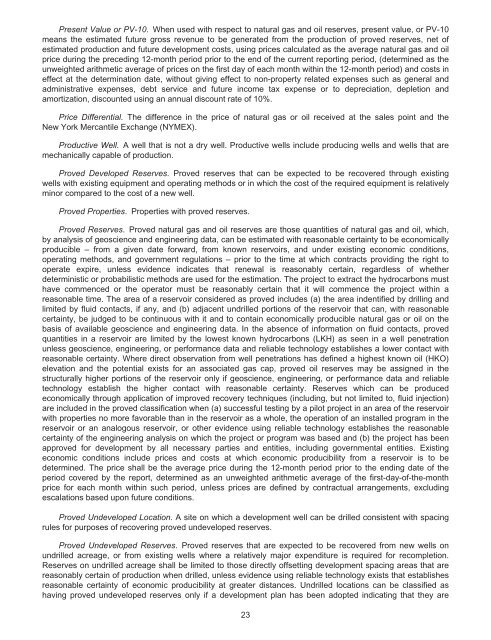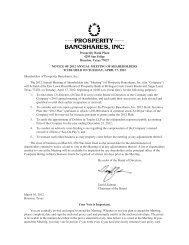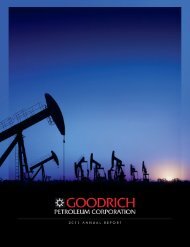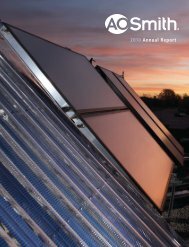6 5 - RR DONNELLEY FINANCIAL - External Home Login
6 5 - RR DONNELLEY FINANCIAL - External Home Login
6 5 - RR DONNELLEY FINANCIAL - External Home Login
You also want an ePaper? Increase the reach of your titles
YUMPU automatically turns print PDFs into web optimized ePapers that Google loves.
Present Value or PV-10. When used with respect to natural gas and oil reserves, present value, or PV-10<br />
means the estimated future gross revenue to be generated from the production of proved reserves, net of<br />
estimated production and future development costs, using prices calculated as the average natural gas and oil<br />
price during the preceding 12-month period prior to the end of the current reporting period, (determined as the<br />
unweighted arithmetic average of prices on the first day of each month within the 12-month period) and costs in<br />
effect at the determination date, without giving effect to non-property related expenses such as general and<br />
administrative expenses, debt service and future income tax expense or to depreciation, depletion and<br />
amortization, discounted using an annual discount rate of 10%.<br />
Price Differential. The difference in the price of natural gas or oil received at the sales point and the<br />
New York Mercantile Exchange (NYMEX).<br />
Productive Well. A well that is not a dry well. Productive wells include producing wells and wells that are<br />
mechanically capable of production.<br />
Proved Developed Reserves. Proved reserves that can be expected to be recovered through existing<br />
wells with existing equipment and operating methods or in which the cost of the required equipment is relatively<br />
minor compared to the cost of a new well.<br />
Proved Properties. Properties with proved reserves.<br />
Proved Reserves. Proved natural gas and oil reserves are those quantities of natural gas and oil, which,<br />
by analysis of geoscience and engineering data, can be estimated with reasonable certainty to be economically<br />
producible – from a given date forward, from known reservoirs, and under existing economic conditions,<br />
operating methods, and government regulations – prior to the time at which contracts providing the right to<br />
operate expire, unless evidence indicates that renewal is reasonably certain, regardless of whether<br />
deterministic or probabilistic methods are used for the estimation. The project to extract the hydrocarbons must<br />
have commenced or the operator must be reasonably certain that it will commence the project within a<br />
reasonable time. The area of a reservoir considered as proved includes (a) the area indentified by drilling and<br />
limited by fluid contacts, if any, and (b) adjacent undrilled portions of the reservoir that can, with reasonable<br />
certainty, be judged to be continuous with it and to contain economically producible natural gas or oil on the<br />
basis of available geoscience and engineering data. In the absence of information on fluid contacts, proved<br />
quantities in a reservoir are limited by the lowest known hydrocarbons (LKH) as seen in a well penetration<br />
unless geoscience, engineering, or performance data and reliable technology establishes a lower contact with<br />
reasonable certainty. Where direct observation from well penetrations has defined a highest known oil (HKO)<br />
elevation and the potential exists for an associated gas cap, proved oil reserves may be assigned in the<br />
structurally higher portions of the reservoir only if geoscience, engineering, or performance data and reliable<br />
technology establish the higher contact with reasonable certainty. Reserves which can be produced<br />
economically through application of improved recovery techniques (including, but not limited to, fluid injection)<br />
are included in the proved classification when (a) successful testing by a pilot project in an area of the reservoir<br />
with properties no more favorable than in the reservoir as a whole, the operation of an installed program in the<br />
reservoir or an analogous reservoir, or other evidence using reliable technology establishes the reasonable<br />
certainty of the engineering analysis on which the project or program was based and (b) the project has been<br />
approved for development by all necessary parties and entities, including governmental entities. Existing<br />
economic conditions include prices and costs at which economic producibility from a reservoir is to be<br />
determined. The price shall be the average price during the 12-month period prior to the ending date of the<br />
period covered by the report, determined as an unweighted arithmetic average of the first-day-of-the-month<br />
price for each month within such period, unless prices are defined by contractual arrangements, excluding<br />
escalations based upon future conditions.<br />
Proved Undeveloped Location. A site on which a development well can be drilled consistent with spacing<br />
rules for purposes of recovering proved undeveloped reserves.<br />
Proved Undeveloped Reserves. Proved reserves that are expected to be recovered from new wells on<br />
undrilled acreage, or from existing wells where a relatively major expenditure is required for recompletion.<br />
Reserves on undrilled acreage shall be limited to those directly offsetting development spacing areas that are<br />
reasonably certain of production when drilled, unless evidence using reliable technology exists that establishes<br />
reasonable certainty of economic producibility at greater distances. Undrilled locations can be classified as<br />
having proved undeveloped reserves only if a development plan has been adopted indicating that they are<br />
23











